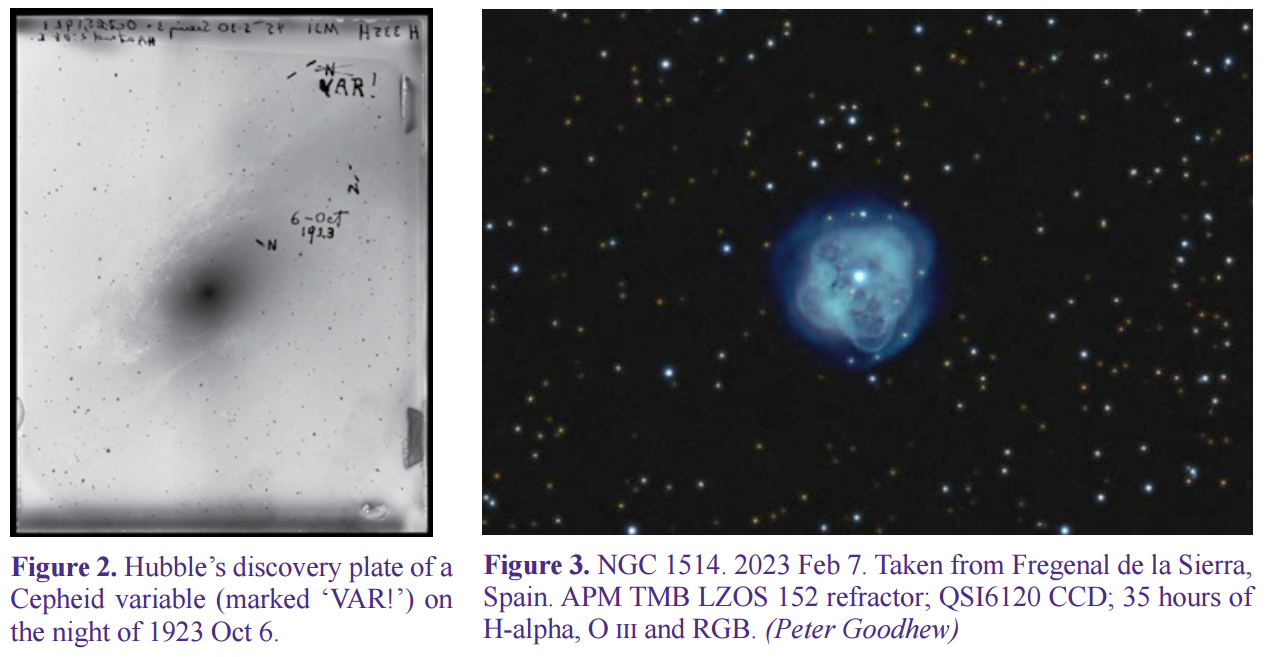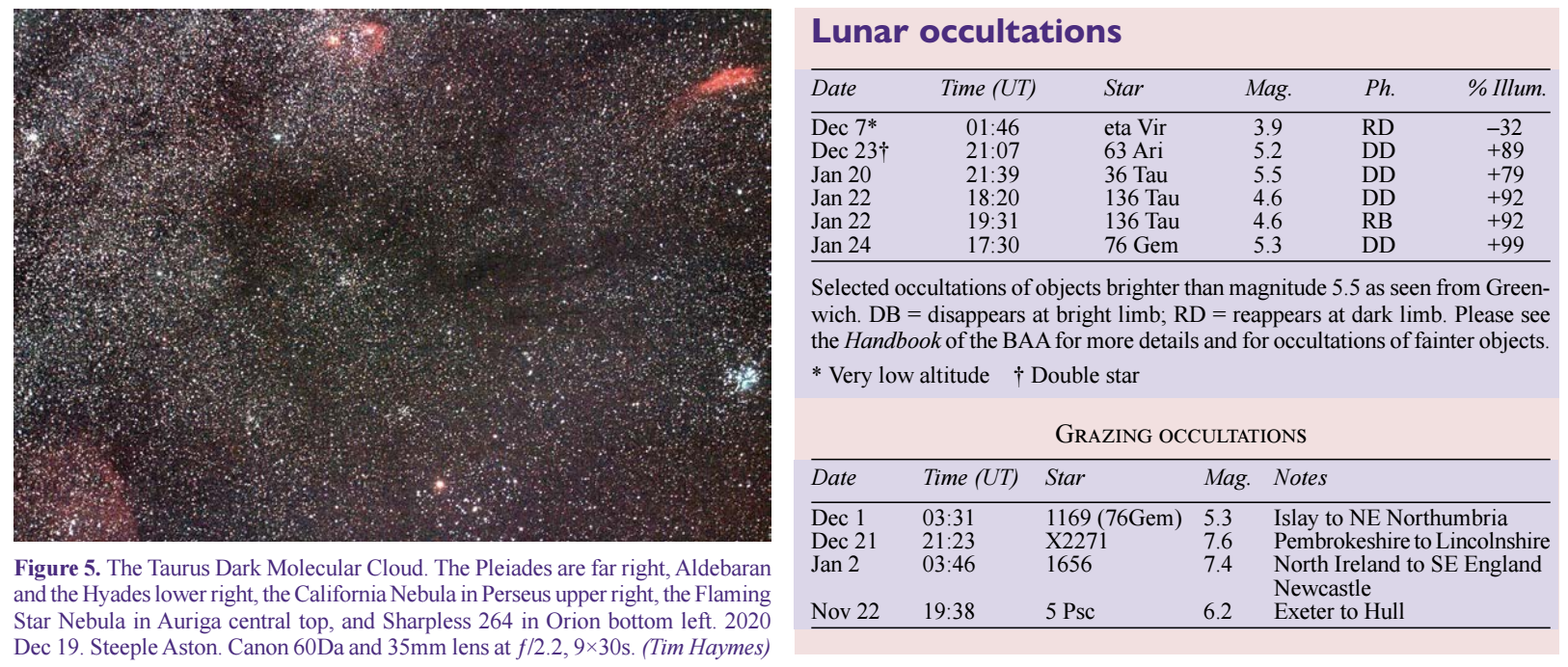Sky notes for 2023 December & 2024 January
2023 December 1

The long nights of deep winter are dreaded by most but adored by astronomers. Clear, frosty, transparent evenings, with Orion and his winter retinue, can be brilliant. The celestial hunter is back in all his splendour, aiding our orienteering around the winter sky.
The autumn stars remain well placed, with Local Group galaxies on show in the west. One hundred years ago, in 1923 October, Edwin Hubble was photographing the ‘Great Andromeda nebula’ as it was then known, using the 100-inch Hooker telescope on Mount Wilson. He noted three ‘new’ stars on the plate, one of which proved to be a Cepheid variable with a period of 31 days, from which he calculated Messier 31 to be a million light-years away. His plate of Oct 6 is marked ‘VAR!’ as he realised this was not a nova but a variable. What a breakthrough! We now know that this huge, majestic spiral is 2.5 million light-years distant, but with this insight he revolutionised the distance scale of the Universe. The spiral nebulae were indeed galaxies beyond the Milky Way.
To the east of Andromeda lies the zodiacal constellation of Taurus, the Bull. Easily located using the stars of Orion’s Belt and extrapolating north-west, orange Aldebaran represents the bovine eye, with the loose cluster of the Hyades to its west. Aldebaran itself is not a cluster member, being 65 light-years away, while the Hyades is the nearest open cluster to us at around 150 light-years distant. Before Gaia, it was a fundamental stepping stone to work out the distances to more remote clusters using the Main Sequence matching method.
While the Hyades and Pleiades are both bright naked-eye and binocular favourites, Taurus boasts several other easy targets for smaller telescopes. The open clusters NGC 1647 and 1746 sit to the Hyades’ east, the former on the Bull’s brow, the latter between the ‘horns’. These are fairly typical of their type, perhaps understandably overlooked in favour of brighter neighbours. Nearby is the contrasted pair, NGC 1807 and 1817, which are often dubbed the ‘poor person’s double cluster’, a more challenging target.
If you think all deep sky objects within Taurus are clusters, think again. Between the horn tips lies the most famous of the supernova remnants, the Crab Nebula. Messier 1 (NGC 1952) is the disseminating gas and dust from the Type 2 supernova seen in 1054 AD. This massive star met a violent end when its core collapsed. It is a reasonably easy object to find and observe visually, at magnitude 8.4. Its ghostly light covers 7 × 4 arcminutes but detail is difficult – imaging brings out much more structure.

A gentler stellar demise is visible in NGC 1514, the famous planetary nebula whose faint, green-blue disc surrounding its 8th magnitude star suggested to William Herschel it was gaseous, rather than an unresolved cluster. The gas is the expanding envelope of a red giant, the final phase of evolution of a Sun-like star. Located north of the Pleiades on the Perseus border, it is best found by hopping to Atik (zeta Persei) and sweeping southeast, or alternatively drifting east to 41 Tauri (magnitude 5.1), then northeast to 42 Tauri (Psi, magnitude 5.2) and then the same distance to NGC 1514. It is nicknamed the Crystal Ball nebula and is not that easy visually; the central star is straightforward enough at magnitude 9.4 but the nebula can be elusive, often looking as if the eyepiece has misted up. It is around 2 arcminutes in diameter, but colour is tricky without large telescopes.

At the other end of the stellar evolution story lies Hind’s nebula and its associated Young Stellar Object (YSO), T Tauri. Just north of the Hyades, T Tauri was found by John Russell Hind from Regent’s Park in London in 1852. To Hind’s astonishment, and that of his contemporaries, it ‘vanished’ for some years, only to be recovered visually by E. E. Barnard and S. W. Burnham in the 1890s using the 36-inch Lick refractor. It still changes, as can be seen in Figure 4.

T Tauri is one of several YSOs visible on the edge of the Taurus Dark Molecular Cloud, the nearest to us at 450 light-years. Another T Tauri star associated with a faint nebula, RR Tauri also formed from the Taurus Dark Cloud and is adjacent to a reflection nebula that George Herbig noted as variable in the 1950s. It has not been studied much, although modern instrumentation may be able to show change, thus adding to our numbers of variable nebulae.
Back to Orion, our seasonal signpost. To the southwest lies Eridanus, flowing sedately into the southern hemisphere, springing from just west of Rigel and containing many galaxies as it meanders west, then east, then west again (see p.396). Nearer to Rigel is the extraordinary Witch Head Nebula, NGC 1909 or IC2118. This large, faint reflection nebula is scattering Rigel’s light and extends 3 × 1 degrees, so requires a widefield approach. The NGC number refers to the ‘brightest’ central portion. It is unclear whether it is an ancient supernova remnant, or shocked gas from star formation.

An easier target in Eridanus is a super triple star, omicron2 or 40 Eridani. Three of the most common stars in the Galaxy are featured in this one system, named Kaid. In this 4th-magnitude family we have a deep yellow K-type star accompanied by a 9th-magnitude white dwarf (40 Eridani B) and an 11th-magnitude red dwarf (40 Eridani C), the most common of stars but due to their faintness, not easy to find. Locating Keid is easy as it is paired with Beid, or omicron1 (also 4th magnitude), and Keid is the southeasterly of these. They are close: a mere 16 light-years away.
The solar system
The active Sun is at its lowest altitude during the solstice on Dec 22. The short days hamper observation but as the Sun has been busy throughout 2023, it remains a worthwhile target.
There are no solar or lunar eclipses during this period.
Mercury reaches greatest eastern elongation on Dec 4 but will be poor before inferior conjunction on Dec 22. In the new year, the speedy world races to western elongation by Jan 12. It can be found low down in the southeast before sunrise at magnitude –0.3 but rather small at 7 arcseconds. It becomes smaller and lower by the end of January.
Venus remains a brilliant beacon before sunrise but is dipping into the morning glow by the end of January, even fading to below –4, and the disc shrinks to 12 arcseconds as the gibbous phase increases.
Mars passed superior conjunction in November but is still unobservable from Britain. From much further south than the UK, Mars is very close to Mercury at the end of January. It is only 4 arcseconds in diameter and magnitude +1.4 so Mars enthusiasts will require patience until the end of 2024.
Jupiter passed opposition in early November so remains high and bright for easy evening viewing in southern Aries. Although slightly fainter than at opposition, it remains a magnificent –2.6 on New Year’s Day.
Saturn lies in Aquarius in early December and is best observed in early evening when on the meridian. It dips low into the southwest by January and is almost lost by the end of the month.
Uranus in western Aries is very well placed through December and January. The small disc is 3.8 arcseconds and magnitude 5.5.
Neptune graces Aquarius early evening but is low and the optimum time to see this distant world, almost 30 astronomical units away, is now past.
Minor planet 4 Vesta is easily located at magnitude 6.4 between December and January as it first passes the Monkey Head Nebula, NGC 2174, in Orion before moving into Taurus, skating just north of 3rd-magnitude Tianguan (zeta Tauri) on Jan 9 and then just south of the Crab Nebula on Jan 12. 3 Juno is much fainter, in southern Leo at magnitude 9.5.
Meteors
The Geminids are best viewed on the night of Dec 14–15 and can be the richest shower of the year. As the Moon is New on Dec 11, it is looking very good this year, weather-willing. Debris from asteroid 3200 Phaethon is thought to be responsible.
The Quadrantids are often neglected as livers recover early in the New Year and in 2024 may be compromised by a last-quarter Moon in Virgo when at their peak on Jan 4. This window is very narrow but can have a Zenithal Hourly Rate of up to 120, although the meteors tend to be fainter than both the Perseids and Geminids, typically 3–6th magnitude. There is no longer a Quadrant amongst the 88 constellations and the radiant lies between Boötes and Draco. The parent body is thought to be 2003EH1.
Comets
Although no bright comets are available at the time of writing, a few faint but interesting ones are well placed. Two are prone to tantrums and remain worthy of scrutiny through the winter.
29P/Schwassmann–Wachmann is spending December to February near Praesepe, Messier 44, the Beehive cluster in Cancer. It produced several outbursts in 2023 so although faint, it is well worth watching.
12P/Pons–Brooks has been known since 1812, with an orbital period of 71 years. It attained 5th magnitude in 1954 and may exceed that around perihelion in 2024 April. As with all comets, predictions are fraught with difficulty, but it should be observable in Cygnus during January before dawn, passing just south of Messier 29 mid-month. It could be around 10th magnitude by the end of the month. Outbursts were imaged by members in the summer (see vol. 133, p.282–3).
62P/Tsuchinshan may be reasonably bright for small telescopes as it passes perihelion on Dec 25. It can be found in Leo throughout December, passing just north of the Leo Triplet (Messier 65, 66 and NGC 3628) on Dec 28.
103P/Hartley was at its closest to Earth in September but may still be visible in telescopes in the morning sky as it lies in Hydra.
| The British Astronomical Association supports amateur astronomers around the UK and the rest of the world. Find out more about the BAA or join us. |
